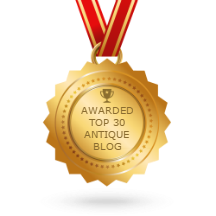
The opulent English furniture style known as Palladian emerged during the early and mid Georgian periods but it stands in marked contrast to Georgian pieces of that time.

These oddball and wildly luxe Palladian antiques are sometimes called Georgian, Georgian Palladian, or just Palladian. Technically, all these names are correct, but for the sake of clarity (and sanity!), it's best to describe them as Palladian because they look so different from all the other antiques that we call Georgian.

Why so different? Because the Palladian style was developed exclusively for the small and extremely wealthy English upper class, composed of families that were really not part of the English mainstream.
This luxurious and frequently gilded furniture was destined for the great country homes, mansions, and palaces of England. As a consequence, Georgian Palladian furniture had little lasting influence on English furniture, never making the leap to common use and acceptance in the Georgian mainstream.
And yet the Palladian look is highly prized because it works so well with other European period pieces. Look how great this Palladian pier mirror looks when paired with a 19th c. French Empire (pronounced AHM peer and dating from 1799-1814) Georges Jacob console:
And yet the Palladian look is highly prized because it works so well with other European period pieces. Look how great this Palladian pier mirror looks when paired with a 19th c. French Empire (pronounced AHM peer and dating from 1799-1814) Georges Jacob console:


And indeed, Palladian furniture is over-the-top ornate, huge, only barely movable and typically embellished with lavish carving. It's really sculpture-like and could just as easily been carved out of stone rather than wood. Look at this Palladian oak doll house to see what I mean:

At C. Mariani, we have an incomparable pair of English Palladian console tables from the estate of George Randolph Hearst Sr. And they can be yours for only $250,000 USD (and if you call in the next 10 minutes I'll thrown in a Sham-Wow dish towel perfect for cleaning those Issori verde marble tops!). Here's one of the pair:


Palladian furniture used many neoclassical elements such as elaborate pediments, masks, eagles (as in the Hearst consoles) and sphinxes. Here is a George II William Kent Palladian mirror that demonstrates the neoclassical influence:
Palladian furniture pieces included side tables and pier tables, usually with marble tops, chairs with top-rail crestings of shells, and legs graced with fish-scaled scrolls, as well as bookcases and gilt wood mirrors.

Often Misunderstood Factoid: A few clients of mine INSIST that the scrolly big-headed fish motif you see above and also on a lot of French 18th century antiques is a STURGEON. A sturgeon? "Pass the caviar please and sorry, but no." These are stylized DOLPHINS, thank you very much.
Palladian furniture was also largely inspired by classical architecture elements.











4 comments:
Fabulous explanation of Palladian furniture....your posts have so many great references..those dark walls really set off all that gilding.
Enlightening article, as always. Did you know that that room is a backdrop for Downton Abbey? http://www.adeenidesigngroup.com/blog/2012/01/20/downton-abbey/
Cheers,
Claudia
was hunting for info on palladian style furniture...ur blog helped big time..! thankyou
I have been researchimg for this all day.
Thank you
Post a Comment